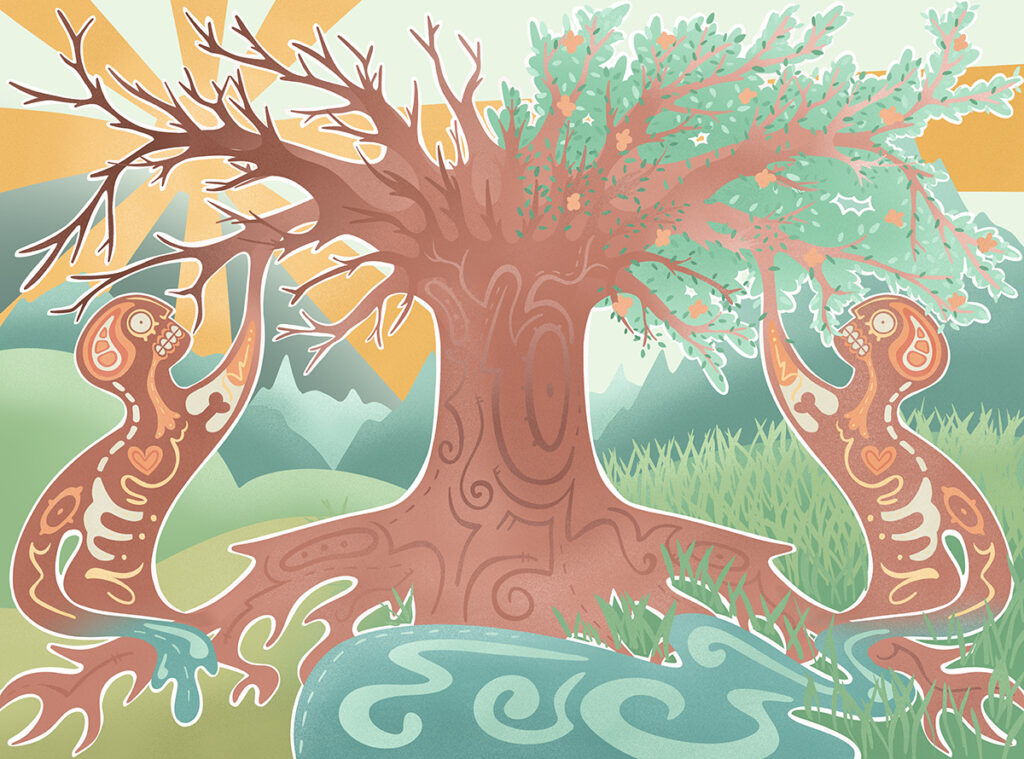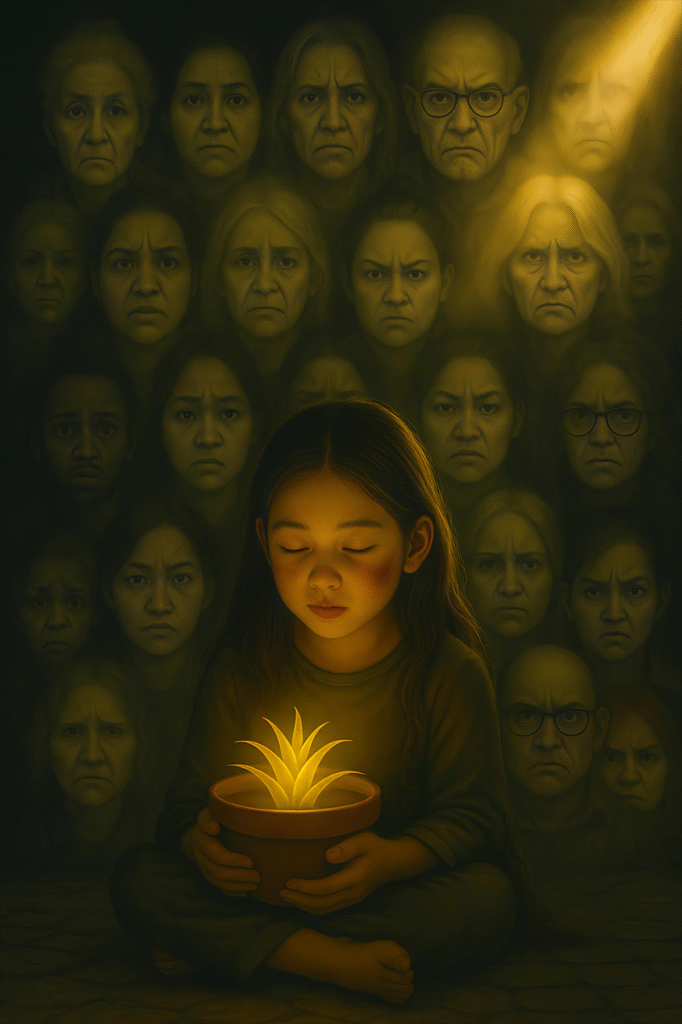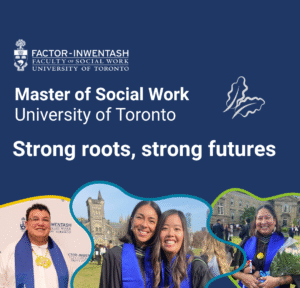Building connection for kids in foster care
Categories: Ashley Quinn, Faculty, Research
The Duality of the Burden and the Bloom, by Caleb Dysart, Nisichiwayasihk Cree Nation. www.moswadesigns.com (Read more about this artwork after the story, below)
Ashley Quinn knows from personal experience that children in the child welfare system often feel disconnected and face serious challenges to their health and well-being.
But when Quinn, an Assistant Professor at the Factor-Inwentash Faculty of Social Work, looked for the data, it wasn’t there.
“No one really knew how children in the child welfare system were doing,” they say. “The national data collected is service-centred and focused on outputs, rather than outcomes. For example, a worker must record whether or not a child had seen a doctor once in that past year, a medical requirement for each child, but this does not provide important information describing the outcomes of this medical appointment, including concerns, assessment results, diagnoses, medication prescriptions, follow-up care, or interventions.”
So Quinn dug deeper. Their research has found that children in care are hospitalized at nearly twice the rate of other children, most often for reproductive and mental health issues, as well as respiratory conditions. The disparities are even more stark for Indigenous children, who are significantly overrepresented in the child welfare system.
For Quinn, these numbers tell a familiar story — one they are determined to change.
Uncovering the rates and reasons for hospitalizations of children in foster care across Canada

Assistant Professor Ashley Quinn
As co-lead, with Dr. Andrea Evans, of a national study linking 2011 Census data with hospital records from across Canada, Quinn and a team of researchers followed over 31,000 children living in foster homes between 2011 and 2017, comparing their hospitalization rates to those of over five million children not in care. Not only were children in foster care nearly twice as likely to be hospitalized, they were over three times more likely to be admitted for pregnancy-related complications or mental health concerns.
“These are children,” Quinn says. “Seeing children who are pregnant and delivering and having reproductive health complications is concerning. And when we see this level of hospitalization for mental and behavioural disorders, such as ADHD, it tells us there are services being missed in the community.”
The researchers grounded their approach in a set of guiding principles, including the recognition that every number represents a child and that the data is intended to make a difference, informed by the people who are affected most. They also note their research does not capture all children, such as those in kinship or customary care, or those who needed help but never received it.
Working in partnership with Inuit, Métis, and First Nations communities, the research followed the First Nations’ OCAP (ownership, control, access, and possession) principles, along with the six R’s of Indigenous research — respect, relevance, reciprocity, responsibility, relationship, and representation. Métis research principles and Inuit Qaujimajatuqangit (IQ) values, which emphasize societal well-being and collective knowledge, also informed the work.
With support from the Edwin S.H. Leong Centre for Healthy Children, Quinn and their team are now building on this foundational research, using 2017 Census data to extend the study on the hospitalization of children in foster care for another seven years.

Sorrow’s Soil, by Tina Cheung, Vancouver. (Read more about this artwork after the story, below.)
This work is personal
The numbers tell a story that mirrors Quinn’s personal experience.
“I was a crown ward and pregnant at 16. I was living on the streets, struggling with my mental health and all of those things,” they say. Feeling disconnected through their experience in the child welfare system, they also felt cut off from their Indigenous culture and cultural identity.
Recognizing how disconnection shaped those early years, Quinn set out to explore how foster parents can support the cultural identity of Indigenous children in their care. In this earlier study, supported by a SSHRC Insight Grant, their research team worked closely with several caregivers to understand their experiences.
They found that even the most committed caregivers often struggled, and that it’s not enough to match Indigenous children with foster parents from the same culture. Helping children in care build meaningful connection with their cultural identity takes humility and self-education — it must be intentional, sustained and rooted in relationship. This finding has helped inform Quinn’s subsequent research into a new model of support for Indigenous children and others in foster care.
High-impact tutoring as connection: A new model of support
Quinn’s most recent initiative, in partnership with TutorBright and Dr. Robert Flynn, a professor emeritus from the University of Ottawa, is testing the efficacy of a high-impact tutoring program designed for young people of all backgrounds in the child welfare system.
What sets the program apart isn’t just the academic support, but the way it’s delivered: through trauma-informed care and Cultural Safety, with a focus on social-emotional learning and growth mindset. By tapping into resilience and the strength built through adversity, this approach is especially powerful for children from low socioeconomic backgrounds. Tutors meet with students several times a week, building consistency and trust. Delivered virtually, the program can remain a constant even as other things in the children’s lives continue to shift.
“Young people in care can experience frequent moves that often result in switching schools too,” says Quinn. “This program offers a steady connection. Someone who shows up for you several times a week, someone who meets you where you’re at and believes in you.”
With support from Mitacs the pilot study will assess the feasibility, fidelity and acceptability of implementing a high-impact, growth mindset and trauma-informed tutoring model to improve educational and well-being outcomes among Indigenous, Crown Ward and child welfare-involved youth. After the pilot project, they will conduct a larger study to evaluate the program’s impact and explore its potential to scale and reach more children.
Building a future of connection
“My hope is that some of the kids we’re working with today will become the tutors themselves,” says Quinn. “That they’ll see their worth and give back in ways that are deeply connected to their own life experiences.”
With each study and intervention, Quinn is working to change the story for children in the child welfare system — building a future of connection, belonging and better care.
By Carolyn Morris
About the images
The artwork shared above were created by young people with lived child welfare experience after they reviewed findings from the national study on hospital rates of youth in foster care, co-led by Quinn and Evans, and reflected on their personal experience.
Visit www.moswadesigns.com to learn more about Caleb Dysart and his work. You can also follow Caleb’s current work on social media at @tallestcree.
Artist statement for Sorrow’s Soil by Tina Cheung:
“This piece emerges from a research-driven inquiry into the long-term health outcomes associated with foster care experience, interwoven with personal narrative and symbolic expression.
“At the heart of the work is a young child, seated alone, holding a glowing aloe plant. A subtle bruise marks her face—a quiet testament to the physical wounds that often precede entry into the foster system. She is encircled by the faces of those lost—through death, displacement, fractured bonds, and institutional failure. These faces are not merely representations of grief; they embody the cumulative weight of relational loss and abandonment that defines many foster care journeys. The overwhelming presence of others paradoxically underscores the isolating reality of the foster experience: to be surrounded by systems, families, and case files—yet profoundly alone.
“This aloneness is more than emotional; it is embodied. It is the absence of consistent caregivers, the disappearance of attachments without explanation, and the silence that often follows trauma. These losses compound over time, contributing to the elevated physical and mental health risks documented in those with histories of out-of-home care.
Yet amidst this solitude, the aloe plant offers a quiet counterpoint. Based on a real aloe vera gifted to me by my first counselor, which I cared for over seven years, it symbolizes the slow, often uncertain process of healing. Known for its regenerative properties, aloe becomes a visual metaphor for resilience—proof that care, when given consistently and with intention, can root even in barren soil.This work invites reflection on how abandonment and chronic disconnection shape health and identity across the lifespan, and how even in the most isolated spaces, the potential for healing may persist—small, glowing, and alive.”
 Are you an Indigenous social worker, social service worker or professional interested in pursuing your MSW?
Are you an Indigenous social worker, social service worker or professional interested in pursuing your MSW?
Join us online for an engaging information session on July 15, 12 to 1pm EST to learn about our Master of Social Work programs, financial support & more!
Register for the information session via eventbrite.
Related:
- Ashley Quinn’s research is promoting cultural connections and identity for Indigenous children in the child welfare system
- A bitter truth: 30 years of child welfare data collection reveals deep systemic inequities, racism and harm
- Q & A: Assistant Professor Ashley Quinn seeks to provide an experiential learning environment where students can engage with Indigenous worldviews and perspectives
- VIDEO: Decolonizing Pathways Towards Integrative Healing in Social Work
- Q & A: Rebecca Schuss (MSW 2020) shares how her experience studying Indigenous Trauma and Resiliency at the Factor-Inwentash Faculty led to law school